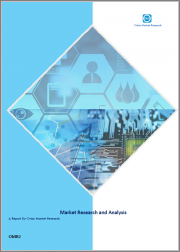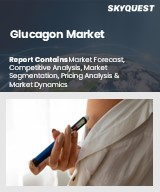
|
시장보고서
상품코드
1380413
세계의 펩타이드 약물 복합체(PDC) 시장(2023-2030년)Global Peptide Drug Conjugates Market 2023-2030 |
||||||
세계 펩타이드 약물 복합체 시장은 예측 기간(2023-2030년) 동안 9.4%의 CAGR을 나타낼 것으로 예상됩니다. 이 시장의 배경에는 암 및 대사성 질환의 유병률 증가, 신약 연구개발 투자 증가, 의약품 개발 기술 발전 등이 있으며, Globocan 2020에 따르면 암 환자 수는 5,055만 2,287명입니다. 이 중 1,929만 2,789명이 새로 암 진단을 받았습니다.
부문별 전망
펩타이드 약물 복합체 세계 시장에서 머플루펜의 하위 부문이 큰 비중을 차지할 것으로 예상됩니다.
제품 중 멜플루펜의 하위 부문은 세계 펩타이드 약물 복합체 시장에서 상당한 점유율을 차지할 것으로 예상됩니다. 이 부문의 성장은 현재 치료 옵션에 대한 인식 증가, 유리한 상환 정책, 멜플루펜의 출시, 암 치료에서 PDC 약물의 급속한 보급에 기인합니다. 2021년 2월, FDA는 덱사메타손과 함께 사용하는 최초의 항암 펩타이드 약물 복합체, 멜파란플루페나미드(멜플루펜)를 승인했습니다. 스웨덴의 생명공학 기업 Oncopeptides AB가 2상 HORIZON 연구를 바탕으로 개발한 이 제품은 조기 승인을 받았습니다. 이 약은 4종 이상의 이전 치료 경험이 있고 최소 1종의 프로테아좀 억제제, 1종의 면역조절제, 1종의 CD38 지향성 단일클론 항체에 내성을 보이는 난치성 다발성 골수종 성인 환자를 대상으로 합니다.
지역별 전망
세계 펩타이드 약물 복합체 시장은 북미(미국, 캐나다), 유럽(영국, 이탈리아, 스페인, 독일, 프랑스, 기타 유럽), 아시아태평양(인도, 중국, 일본, 한국, 기타 아시아 지역), 기타 지역(중동 및 아프리카, 중남미) 등 지역별로 세분화되어 있습니다. 세분화됩니다. 그 중에서도 아시아태평양은 새로운 배송 시스템 개발 및 상용화를 위한 투자가 증가함에 따라 세계에서 두드러진 점유율을 차지할 것으로 예상됩니다.
북미는 펩타이드 약물 복합체 세계 시장에서 높은 CAGR로 성장할 것으로 예상됩니다.
모든 지역 중 북미는 예측 기간 동안 상당한 CAGR로 성장할 것으로 예상됩니다. 북미 시장을 이끄는 주요 요인은 이 지역 전체에서 암 환자가 증가하고 있으며, 이는 향후 몇 년동안 펩타이드 약물 복합체 시장의 성장에 확실히 영향을 미칠 것으로 추정됩니다. 미국암협회(ACS)에 따르면 2022년 미국에서 약 198,030명의 신규 암환자와 609,360명의 암 사망자가 발생할 것으로 예상되며, Royal Society Publishing Organization의 보고서에 따르면 하이브리드 펩타이드인 HPRP-A 1-TAT는 세포막을 파괴하여 세포질 내용물을 빠르게 누출시킬 수 있으며, 강력한 항암 효과가 있습니다.
목차
제1장 보고서 개요
- 업계 현황 분석과 성장 가능성 전망
- 조사 방법과 툴
- 시장 내역
- 부문별
- 지역별
제2장 시장 개요와 인사이트
- 조사 범위
- 애널리스트 인사이트와 현재 시장 동향
- 주요 조사 결과
- 추천 사항
- 결론
제3장 경쟁 구도
- 주요 기업 분석
- Angiochem Inc.
- 개요
- 재무 분석
- SWOT 분석
- 최근 동향
- Bicycle Therapeutics, Inc.
- 기업 개요
- 재무 분석
- SWOT 분석
- 최근 동향
- Cybrexa Therapeutics Inc.
- 개요
- 재무 분석
- SWOT 분석
- 최근 동향
- Novartis AG
- 개요
- 재무 분석
- SWOT 분석
- 최근 동향
- Oncopeptides AB
- 개요
- 재무 분석
- SWOT 분석
- 최근 동향
- 주요 전략 분석
제4장 시장 세분화
- 세계의 펩티드 약물 복합체 시장 : 유형별
- 진단
- 치료
- 세계의 펩티드 약물 복합체 시장 : 제품별
- Melflufen
- Lutetium
- ANG1005
- BT1718
- CBX-12
제5장 지역 분석
- 북미
- 미국
- 캐나다
- 유럽
- 영국
- 독일
- 이탈리아
- 스페인
- 프랑스
- 기타 유럽
- 아시아태평양
- 중국
- 인도
- 일본
- 한국
- 기타 아시아태평양
- 기타 지역
제6장 기업 개요
- AstraZeneca co.
- Camurus AB
- Chiasma, Inc.
- CRINETICS PHARMACEUTICALS
- Dauntless Pharmaceuticals
- Ipsen Biopharmaceuticals, Inc.
- Midatech Pharma PLC
- PeptiDream Inc.
- Peptron, Inc.
- Pfizer Inc.,
- Soricimed Biopharma
- Teva Pharmaceuticals Inc.
- Theratechnologies Inc.
- Validus Pharmaceuticals LLC
- WuXi AppTec Co., Ltd.
Title: Global Peptide Drug Conjugates Market Size, Share & Trends Analysis Report by Type (Diagnostic and Therapeutic), and by Product (Melflufen, Lutetium, ANG1005, BT1718 and CBX-12),Forecast Period (2023-2030).
The global peptide drug conjugates market is anticipated to grow at a CAGR of 9.4% during the Forecast Period (2023-2030). The market is attributed to factors including the increasing prevalence of cancer and metabolic disorders, rising investments in the R&D of novel drugs, and technological advancements in drug development. According to the Globocan 2020, number of cancer cases were 50,550,287. Of which, the total number of new cases 19,292,789 around the globe.
Segmental Outlook
The global peptide drug conjugates market is segmented on the type, and product. Based on the type, the market is sub-segmented into diagnostic and therapeutic. Based on the product, the market is sub-segmented into melflufen, lutetium, ANG1005, BT1718 and CBX-12. Among the type, the therapeutic sub-segment is anticipated to hold a considerable share of the market, owing to the emerging targeted therapeutic that present increased tumor penetration and selectivity.
The Melflufen Sub-Segment is Anticipated to Hold a Considerable Share of the Global Peptide Drug Conjugates Market
Among the product, the melflufen sub-segment is expected to hold a considerable share of the global Peptide Drug Conjugates market. The segmental growth is attributed to the owing to increasing awareness about current treatment options, favorable reimbursement policies, the launch of Melflufen and rapid uptake of PDC drugs in cancer therapy., In February 2021, the FDA approved the first anticancer peptide-drug conjugate, melphalan flufenamide, or melflufen, for use in combination with dexamethasone. Based on the phase 2 HORIZON research, the product, developed by the Swedish biotech company Oncopeptides AB, received accelerated approval. In adult patients with refractory multiple myeloma, who have received at least 4 prior lines of therapy and whose disease is refractory to at least 1 proteasome inhibitor, 1 immunomodulatory agent, and 1 CD38-directed monoclonal antibody.
Regional Outlook
The global peptide drug conjugates market is further segmented based on geography including North America (the US, and Canada), Europe (UK, Italy, Spain, Germany, France, and the Rest of Europe), Asia-Pacific (India, China, Japan, South Korea, and Rest of Asia), and the Rest of the World (the Middle East & Africa, and Latin America). Among these, Asia-Pacific is anticipated to hold a prominent share of the market across the globe, owing to the rising investments to develop and commercialize new delivery systems.
The North America Region is Expected to Grow at a Significant CAGR in the Global Peptide Drug Conjugates Market
Among all regions, the North America regions is anticipated to grow at a considerable CAGR over the forecast period. The major factors driving the North America market is the increasing number of cancer cases across the region is estimated to certainly impact the peptide drug conjugates market growth in upcoming years. According to the American Cancer Society (ACS), in 2022, around 1,918,030 new cancer cases and 609,360 cancer mortalities were reported in the US. As per the reports of Royal Society Publishing Organization, HPRP-A1-TAT, a hybrid peptide, can destroy the cell membrane to cause rapid leakage of cytoplasmic contents, and has a strong anti-cancer activity.
Market Players Outlook
The major companies serving the global peptide drug conjugates market include: Angiochem Inc., Bicycle Therapeutics, Inc., Cybrexa Therapeutics Inc., Novartis AG, Oncopeptides AB, and others. The market players are considerably contributing to the market growth by the adoption of various strategies including mergers and acquisitions, partnerships, collaborations, funding, and new product launches, to stay competitive in the market. For instance, in September 2023, PeptiDream Inc., a public Kanagawa, Japan-based biopharmaceutical company entered into a new multi-target collaboration and license agreement with US based Genentech, a member of the Roche Group, targeted on the discovery and development of novel macrocyclic peptide-radioisotope drug conjugates.
The Report Covers:
- Market value data analysis of 2022 and forecast to 2030.
- Annualized market revenues ($ million) for each market segment.
- Country-wise analysis of major geographical regions.
- Key companies operating in the global peptide drug conjugates market. Based on the availability of data, information related to new product launches, and relevant news is also available in the report.
- Analysis of business strategies by identifying the key market segments positioned for strong growth in the future.
- Analysis of market-entry and market expansion strategies.
- Competitive strategies by identifying 'who-stands-where' in the market.
Table of Contents
1. Report Summary
- Current Industry Analysis and Growth Potential Outlook
- 1.1. Research Methods and Tools
- 1.2. Market Breakdown
- 1.2.1. By Segments
- 1.2.2. By Region
2. Market Overview and Insights
- 2.1. Scope of the Report
- 2.2. Analyst Insight & Current Market Trends
- 2.2.1. Key Findings
- 2.2.2. Recommendations
- 2.2.3. Conclusion
3. Competitive Landscape
- 3.1. Key Company Analysis
- 3.2. Angiochem Inc.
- 3.2.1. Overview
- 3.2.2. Financial Analysis
- 3.2.3. SWOT Analysis
- 3.2.4. Recent Developments
- 3.3. Bicycle Therapeutics, Inc.
- 3.3.1. Overview
- 3.3.2. Financial Analysis
- 3.3.3. SWOT Analysis
- 3.3.4. Recent Developments
- 3.4. Cybrexa Therapeutics Inc.
- 3.4.1. Overview
- 3.4.2. Financial Analysis
- 3.4.3. SWOT Analysis
- 3.4.4. Recent Developments
- 3.5. Novartis AG
- 3.5.1. Overview
- 3.5.2. Financial Analysis
- 3.5.3. SWOT Analysis
- 3.5.4. Recent Developments
- 3.6. Oncopeptides AB
- 3.6.1. Overview
- 3.6.2. Financial Analysis
- 3.6.3. SWOT Analysis
- 3.6.4. Recent Developments
- 3.7. Key Strategy Analysis
4. Market Segmentation
- 4.1. Global Peptide Drug Conjugates Market by Type
- 4.1.1. Diagnostic
- 4.1.2. Therapeutic
- 4.2. Global Peptide Drug Conjugates Market by Product
- 4.2.1. Melflufen
- 4.2.2. Lutetium
- 4.2.3. ANG1005
- 4.2.4. BT1718
- 4.2.5. CBX-12
5. Regional Analysis
- 5.1. North America
- 5.1.1. United States
- 5.1.2. Canada
- 5.2. Europe
- 5.2.1. UK
- 5.2.2. Germany
- 5.2.3. Italy
- 5.2.4. Spain
- 5.2.5. France
- 5.2.6. Rest of Europe
- 5.3. Asia-Pacific
- 5.3.1. China
- 5.3.2. India
- 5.3.3. Japan
- 5.3.4. South Korea
- 5.3.5. Rest of Asia-Pacific
- 5.4. Rest of the World
6. Company Profiles
- 6.1. AstraZeneca co.
- 6.2. Camurus AB
- 6.3. Chiasma, Inc.
- 6.4. CRINETICS PHARMACEUTICALS
- 6.5. Dauntless Pharmaceuticals
- 6.6. Ipsen Biopharmaceuticals, Inc.
- 6.7. Midatech Pharma PLC
- 6.8. PeptiDream Inc.
- 6.9. Peptron, Inc.
- 6.10. Pfizer Inc.,
- 6.11. Soricimed Biopharma
- 6.12. Teva Pharmaceuticals Inc.
- 6.13. Theratechnologies Inc.
- 6.14. Validus Pharmaceuticals LLC
- 6.15. WuXi AppTec Co., Ltd.



















